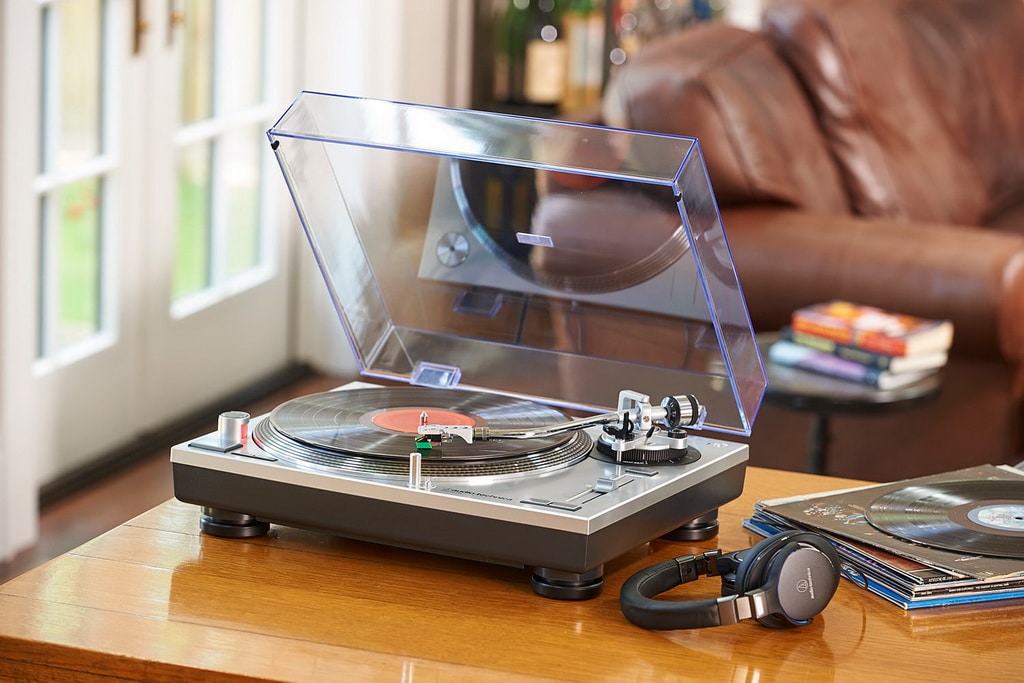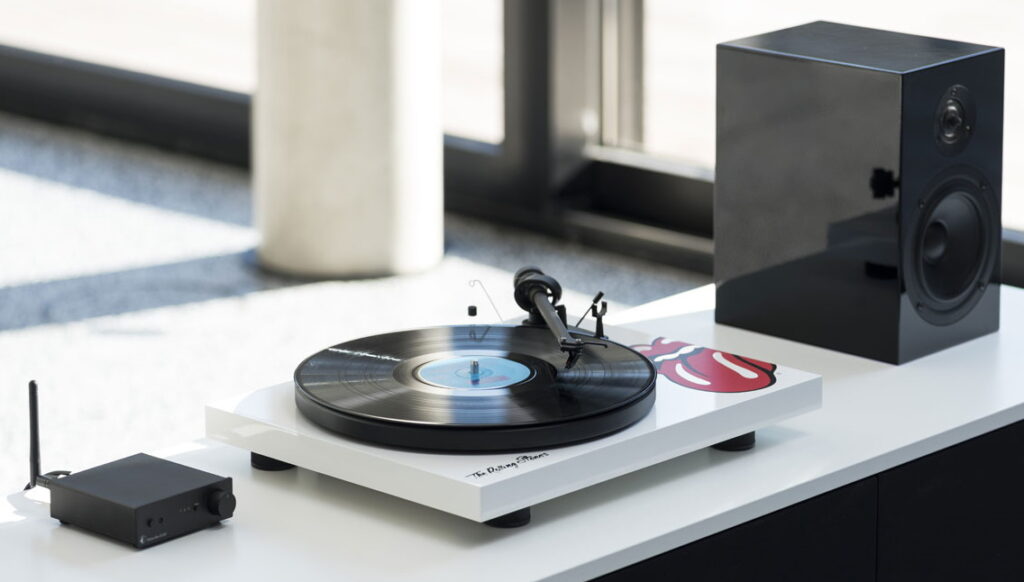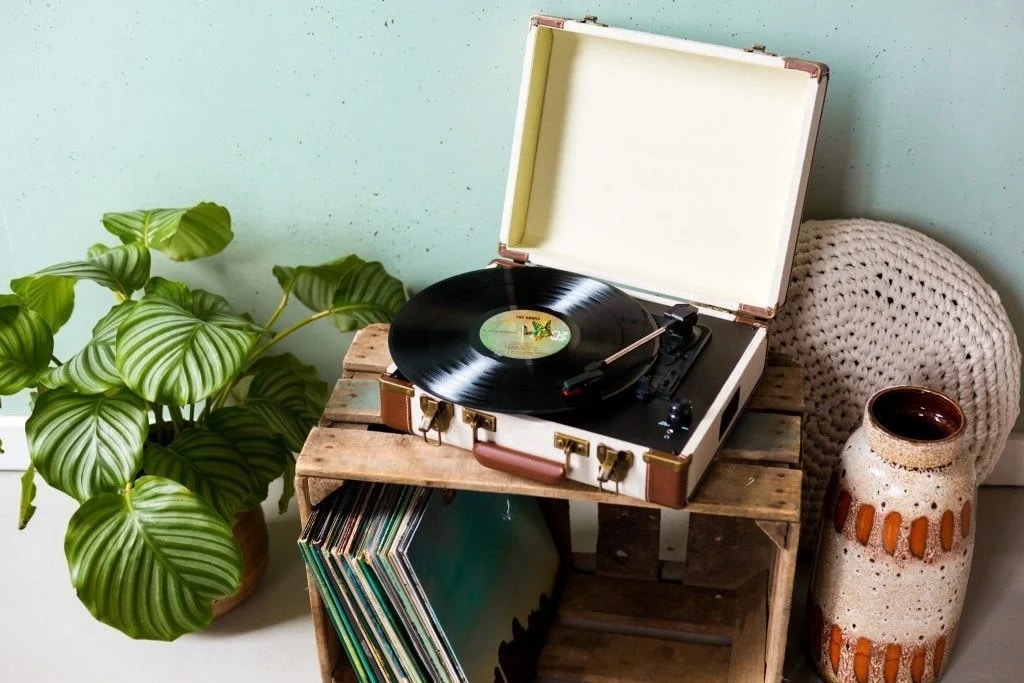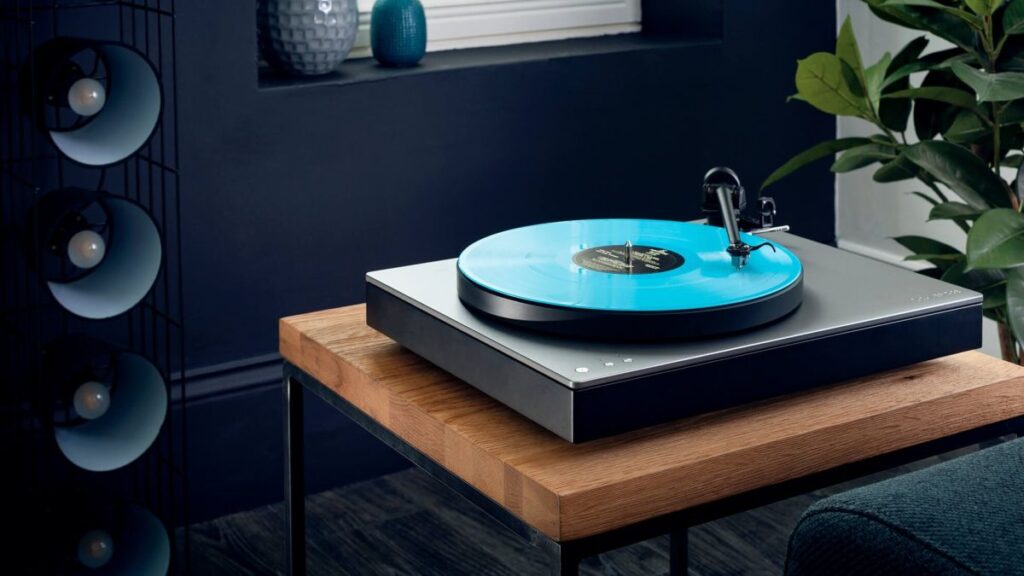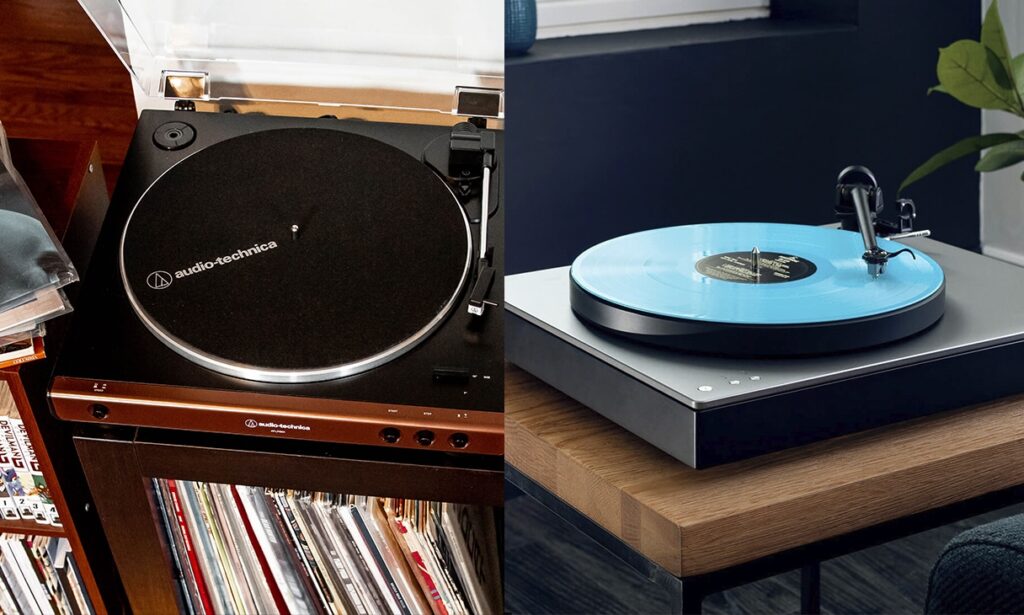There’s something warm and nostalgic about the satisfying ‘thump’ of the needle as it hits the vinyl or the gentle whirr of the motor as it spins the disc. For that, we love automatic turntables a lot!
We spent hours reading through specifications for the most popular models and poring through customer reviews. The result is a list of the 6 best automatic turntables, including the Audio-Technica AT-LP3BK which is the top-rated model. Among the features that affect everything from sound quality to usability to durability, we took into account the rotation speed of the turntable, which affects what sizes of records the turntable can play, and whether it is belt-driven or direct-driven, which affects how long the player will last. The materials of the stylus and platter and the shape of the tonearm are also important in determining the quality and fidelity of the sound playback.
More features: switchable pre-amp modes for moving magnet and moving coil cartridges
This sleek and stylish belt-driven turntable from Audio-Technica is a favorite among customers thanks to its incredible audio playback quality. The turntable is able to handle both 33 1/3 and 45 RPM vinyl and comes with a diamond stylus and a basic-level moving magnet phono cartridge made by Audio-Technica. Although some users would have liked to receive a more advanced cartridge given the price of this turntable, they did appreciate the ability to switch the pre-amp to use either a moving magnet or moving coil cartridge. Users also appreciated the universal headshell that makes it easy to switch out cartridges.
The platter is made from die-cast aluminum and is constructed with a 4.5-mm topsheet of rubber to further reduce vibrations, which is one of the main reasons for the high-quality audio from this turntable. The player also has rubberized feet to help keep it steady when playing vinyl. Users also liked the straight tonearm, which requires balancing when you first get the turntable but is relatively easy to calibrate to the proper force.
The only minor issue that users had with the turntable is that the buttons on the front feel cheaply made compared to the rest of the unit and the white text can get scratched and faded over time. However, it’s still one of the most decent turntables under 200 dollars only.
More features: 5mm thick turntable sheet, built-in phono equalizer
This solidly built belt-drive automatic turntable under 300 dollars from Denon is a great value given the high quality of its audio playback. The moving magnet cartridge with diamond stylus is constructed with a removable headshell, making it easy to change out the cartridge as you wish. Plus, the diamond stylus itself is elliptical rather than conical in shape, which improves the tracking and allows your stylus to last longer.
The die-cast aluminum platter is built with an extra heavy base to reduce vibrations from the motor and from movement in the room. In addition, the 5-mm thick topsheet on the platter further reduces vibrations, and Denon included hologram vibration reduction analysis to provide the best playback quality possible.
One major issue that users noted with this turntable is that the speed adjustment is slightly off, so that the 33 1/3 and 45 RPM settings on the turntable are not quite accurate relative to the vinyl it is playing. Although the exact cause is unknown, it appears to be related to issues with the belt drive rather than the platter. Customers have had mixed support from Denon with this issue, which can lead to significant frustration if this issue happens to your turntable.
Are you looking a belt-driven turntable that delivers cool music and will easily play 78 RPM records? Then you should consider the Vinyl MUSIC ON Retro Record Player. The manufacturer makes some impressive models of turn tables, and this retro model is one of the best in its category. It comes with a sleek, retro appearance that will make your room look elegant. The brown, vanished wood used on the body looks and feels premium. It offers pleasant acoustics while sitting pretty on your table.
It comes as a three-speed phono record player, with the ability to play 33 1/3 RPM, 45 RPM, 78 RPM records. It is also compatible with some devices.
Additionally, the model has a stereo speakers to boost the audibility and help you to thoroughly enjoy playing your music. As a wired connection, it can connect with different units to let you play better. The 3.5mm cable offers more versatility and gives better musical performance.
Due to the compact design, it is easy to transport without fear of damage. It is also made of high quality materials that ensure you will use it for a long time.
Aside from compatibility with wired devices, the wireless connectivity makes it one of the most versatile options on this roundup. You can connect it to Bluetooth devices and play as many songs or records as you desire.
The vintage design and overall build makes it a costly option. However, there are some cheaper alternatives that boast of similar performance.
More features: USB output for direct connection to PCs, iPod, and other compatible USB audio devices
This automatic belt-drive turntable from Sony is perfect for those who want to digitize their vinyl collections thanks to the integrated USB port. In addition to being able to play back vinyl on your computer, the turntable comes with Sony’s Audio Studio software to help you easily and quickly record and optimize your vinyl records. While the turntable can play 33 1/3 and 45 RPM records, note that it cannot be used to play or digitize 78 RPM vinyl.
However, this turntable also performs well as a standalone vinyl player thanks to features like the quality S-shaped tonearm and diamond stylus. This type of tonearm is often seen in turntables under 1000 dollars, however, you can get this model with the the same quality tonearm at a much more affordable price. The platter is slightly raised to reduce vibrations and the turntable itself is heavy enough to keep the sound quality from being affected by motion in the room. The turntable includes a pre-amplifier as well as a 100-foot copper speaker wire, although it is worth noting that the pre-amplifier cannot be switched off if you want to connect to a broader audio system. In addition, the RCA cables are hardwired into the turntable, which makes them difficult to impossible to replace or upgrade.
More features: elegant appearance
If you are determined to get an automatic turntable but don’t want to sacrifice anything on sound quality, this high-end turntable from Thorens is a spectacular – if expensive – choice. The turntable comes with the 95E cartridge from Audio Technica, one of their higher quality cartridges that you won’t find standard on less expensive turntables. Also, Thorens equipped this turntable with their TP 41 tonearm, which is extremely lightweight and counterbalanced so that it sits perfectly on your vinyl for the best tracking and playback quality.
The turntable is able to play both 33 1/3 and 45 RPM vinyl and includes a phono pre-amp to make it easy to hook the turntable up to a set of speakers. However, note that the pre-amp cannot be easily switched off, which might disappoint more serious audiophiles looking to upgrade the pre-amp to something more substantial.
The die-cast aluminum platter is somewhat raised above the base of the turntable in order to help isolate it from any vibrations that are caused by the motor. In addition, the turntable base is constructed with rubberized feet in order to reduce vibrations and further improve sound quality.
More features: noise ratio: >50 dB (DIN-B)
This inexpensive belt-drive turntable from Audio Technica is a great option for those who want to be able to play an old vinyl collection but don’t care to spend hundreds of dollars or more for incredible sound quality. The turntable is able to play both 33 1/3 and 45 RPM vinyl and uses a diamond stylus mounted on a dual magnet phono cartridge. The included pre-amp can be switched between RCA cable and line out modes, making it easy to connect to either a large audio system or simple powered speakers. Plus, Audio Technica offers another version of this turntable, the AT-LP60BK-USB, that has an integrated USB port to allow you to connect to a computer to digitize your vinyl collection.
The playback quality on this turntable is so-so, since there is relatively little vibration reduction beyond the die-cast aluminum platter itself. Users note that people walking around in the same room as the turntable can cause the stylus to jump and skip, although this can be partially alleviated by placing the turntable on a vibration-isolated table with a rubber mat. Note also that the tonearm on this turntable is not counterbalanced, so it is relatively difficult to control the weight of the tonearm on your records compared to more advanced automatic turntables.
Now that you’ve read more about our six favorite automatic turntables currently on the market, how do you choose among them to find the right turntable for you?
Turntables can be difficult to differentiate at first because of the highly specific parts, but taking a closer look at each of the essential components of a turntable can reveal some of the hidden differences between models and help you to understand how you record player functions. In addition, knowing more about these components can help you better recognize when a turntable is a great value for the quality and when a turntable is overpriced for what it delivers. In addition, we’ll cover some questions that beginners commonly ask when they are interested in buying an automatic turntable so that you can be sure you are getting a model that is right for you.
Automatic turntables make operating a vinyl record player a cinch, especially for beginners. Traditional manual turntables require you to place the needle arm onto the record with the right amount of pressure in order to start playing a record, and then to carefully take the arm back off the record when it is finished playing before it starts scratching. If you place too much pressure on the record, or leave the room right before the record finishes, you risk damaging both the record and the stylus of your turntable. Automatic turntables eliminate this problem by automatically regulating the pressure of the stylus on the record – all you have to do is press a button to have the player arm lower itself – and automatically lifting the arm when the record ends.
This convenience comes with an important caveat, however. You won’t find automatic player arms on higher-end turntables because they do slightly impair the audio quality of the record player. The reason is that the platter must leave extra space for the mass of cogs and other mechanical parts involved in actually moving the player arm up and down, which can introduce more vibrations as the record is spinning. In addition, the electrical circuitry in the motorized arm can actually interfere, however slightly, with the current running through the cartridge that reads the record.
While there are some devices that you can place on your player arm to automatically lift the arm at the end of a record, without an automatic turntable you’ll have to know how much pressure to place when applying the arm onto the record. While manual turntables might provide a slight edge in sound quality, for many beginners the risk of damaging decades-old vinyl by misapplying the player arm is a more important consideration.
The rotation speed of a turntable is one of the most essential features to look at when considering a new player and your preference may depend on what vinyl you already have in your collection. Most turntables are designed to play vinyl that are 33 1/3 or 45 RPM and these are the most common sizes of vinyl sold. However, only a few turntables, such as the VInYL MUSIC ON Retro Record Player turntable, are capable of playing those vinyl as well as larger 78 RPM vinyl. If you have 78 RPM records in your collection or prefer the slightly better audio quality of these records, then you will want to search for a turntable that can play at this speed.
Turntables can be split according to whether the motor spins the platter via a belt – known as belt-driven turntables -or whether the motor sits directly underneath the platter – known as direct-drive turntables. The differences between these types is relatively important for DJs using turntables, but when it comes to using an automatic turntable to listen to music there is relatively little difference between them. Belt-driven turntables typically have a slight advantage in music quality since there is less vibration in the platter as compared to direct-drive turntables where the motor is whirring directly below the platter.
The stylus and platter are two of the most important components in any turntable since they will largely determine the sound quality you get when playing back vinyl records. The stylus is the needle that actually tracks through the grooves of your records and is typically made of diamond, although other stylus types are available. It is often worth investing in the best stylus and cartridge that you can afford, and thankfully most turntables can be easily upgraded by changing out the cartridge.
The platter is the part of the turntable that, driven by the motor, actually spins the record. The platter is the point at which your turntable is most susceptible to vibration and noise within your record playback, so having a heavy, solid platter is important for the best sound quality. The majority of modern turntables use platters made from die-cast aluminum, but these platters vary in their weights and whether they have additional vibration reduction features like a rubber mat included.
Tonearms come in a variety of different design configurations because they are another part of every turntable where sound quality can be affected. Some tonearms are straight to provide a uniform movement of the stylus through the record, while others are curved to allow more flexibility in the stylus – like the S-shaped tonearm found on the Sony USB Stereo Turntable. Both styles can introduce some vibration, so there is no single best tonearm style. In general, it is best to opt for a high-quality tonearm when purchasing a new turntable, although you can typically replace the tonearm later if you wish to upgrade your record player.
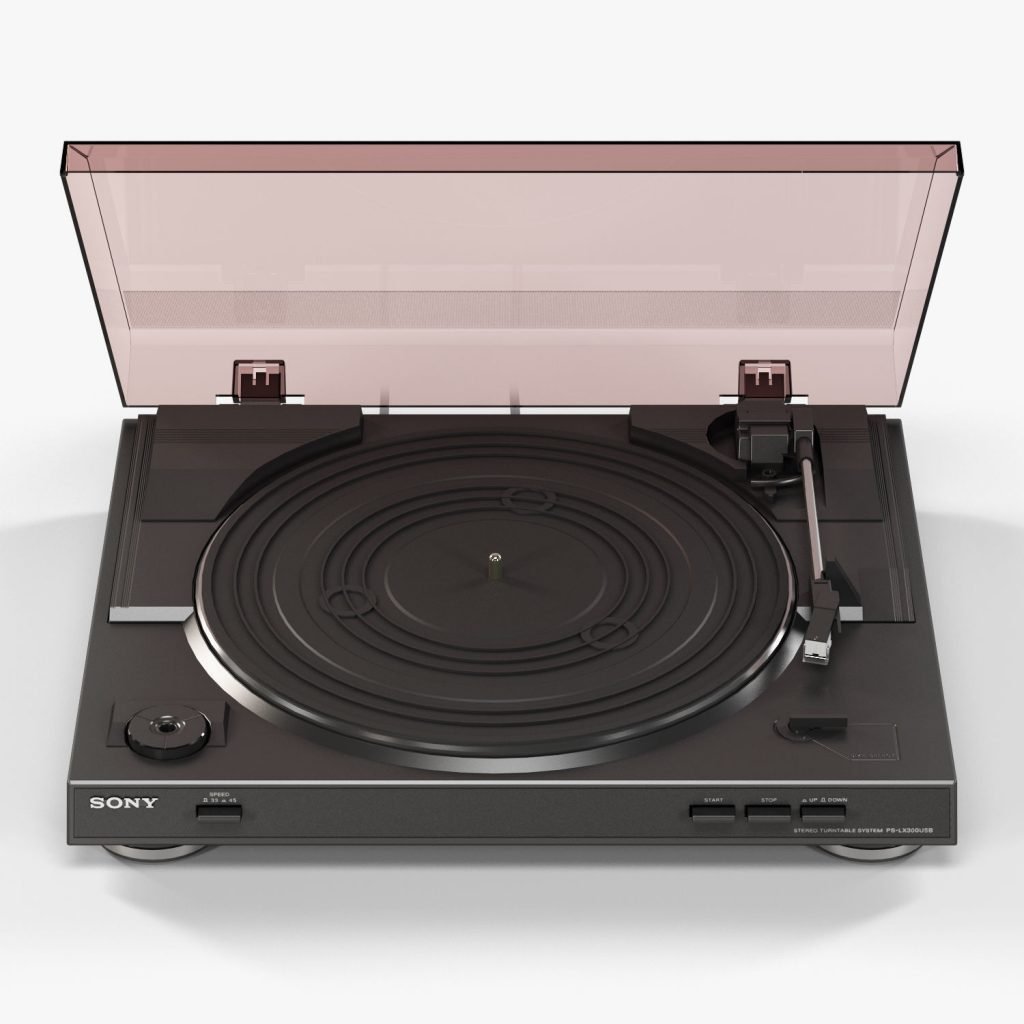
The pre-amplifier is a component that is built into most turntables, including all of the automatic turntables in our review. The purpose of the pre-amplifier is to lift the audio signal from the cartridge to audible levels, which can then be listed to via a set of speakers or headphones through an auxiliary cable. Although pre-amplifiers can be purchased separately from the turntable and connected externally, most amateur vinyl listeners will not want to deal with the hassle of running their turntable through an external pre-amplifier.
The most important extra feature to consider when looking at automatic turntables is whether the turntable offers a USB port for connecting to a computer. These are often seen in the best turntables under 500 dollars, for example. This is important if you want to record audio playback from your vinyl records, for example to digitize your music collection, or to run the audio line through your computer speakers.
Also be sure to look at whether you like the appearance of the turntable you are getting – after all, it is likely a piece of audio equipment that will be displayed prominently in your home. A dust cover can be helpful for protecting the vinyl player when it is not in use and extend the life of your turntable.
Our overall favorite automatic turntables were the Audio Technica AT-LP3BK, the Denon DP-300F, and the Thorens TD 170-1B. All three of these turntables featured heavy-duty platters, and the models from Audio Technica and Denon were constructed with topsheets for additional vibration reduction and higher audio quality. We felt the Audio Technica AT-LP3BK was the overall best automatic turntable on the market today in part because it is one of the few turntables that can use either moving magnet or moving coil cartridges and because it comes with nearly perfectly counterbalanced tonearm. The Denon DP-300F suffers from speed issues related to the belt drive, but otherwise offers terrific playback quality. Meanwhile, we liked the VInYL MUSIC ON Retro Record Player because it is one of the few automatic turntables that is capable of playing 78 RPM vinyl in addition to 33 1/3 and 45 RPM vinyl.
